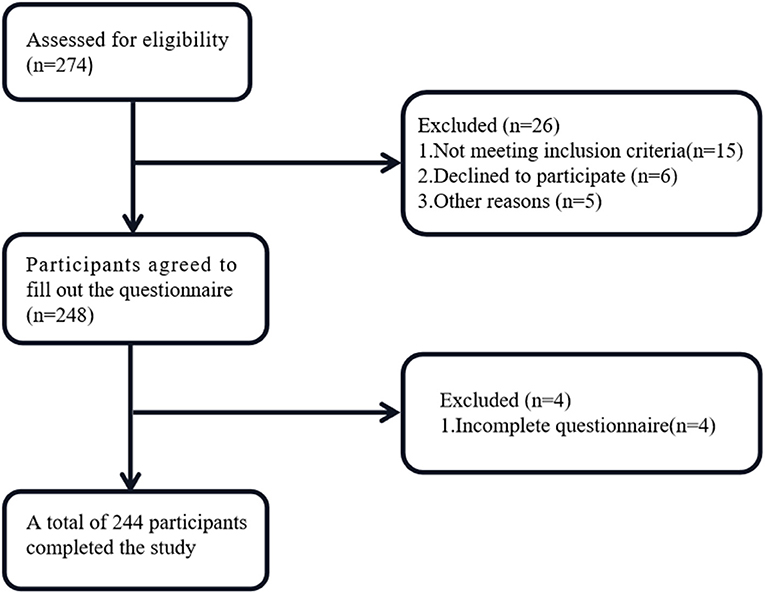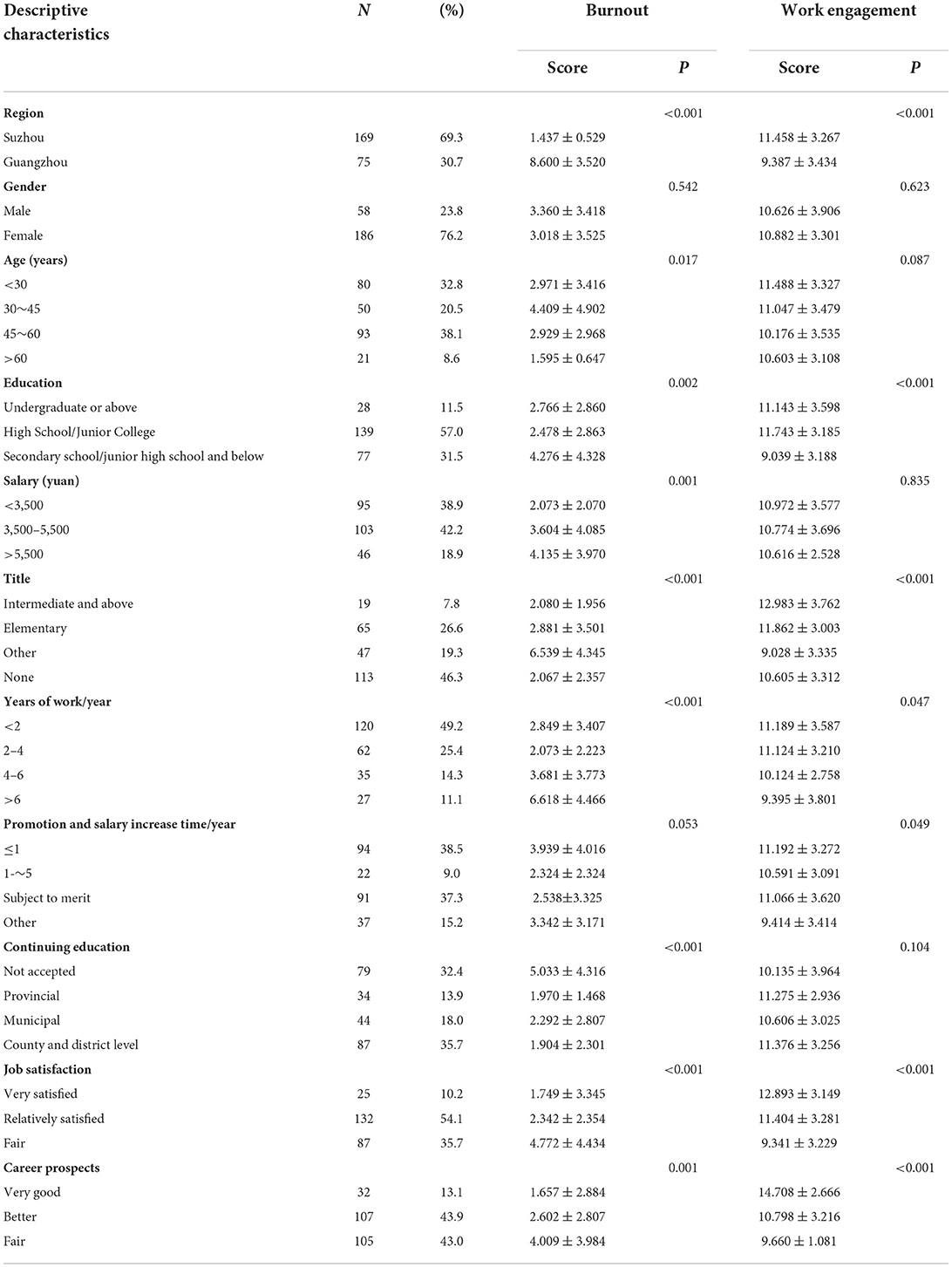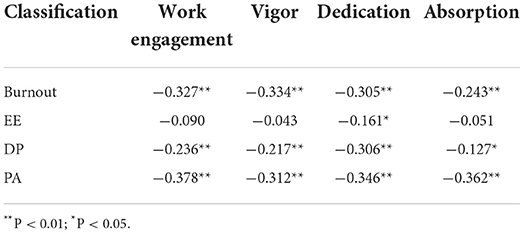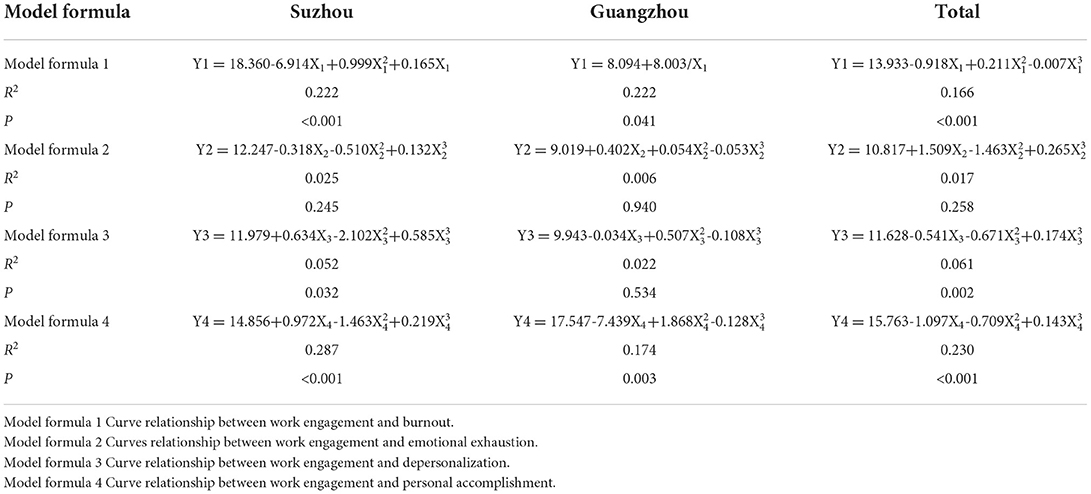- Department of Social Medicine and Health Care Management, School of Public Health, Zhengzhou University, Henan, China
Objective: To investigate whether there is a curvilinear relationship between burnout and work engagement among staff in Chinese community services for the elderly.
Methods: A stratified whole-group random sampling method was used to survey 244 staff members from eight communities in two cities. Data were collected using the Maslach Burnout Inventory scale (MBI) and the Utrecht Work Engagement Scale- 9 (UWES- 9). The curve estimation method explored the functional model of burnout and work engagement scales.
Results: Two hundred forty-four staff members completed the survey. Burnout, depersonalization (DP), and personal accomplishment (PA) were found to be related to work engagement in a cubic function (R2 = 0.166, P < 0.05), (R2 = 0.061, P < 0.05), and (R2 = 0.2230, P < 0.05), respectively. There was no statistically significant relationship between emotional exhaustion (EE) and work engagement (P > 0.05). “Personal Accomplishment” is related to work engagement in a U-shaped curve.
Conclusions: There was a cubic function relationship between burnout and work engagement, where “personal accomplishment” was related to work engagement in a U-shaped curve. Therefore, the government and related service organizations should understand the impact of different levels of burnout on work engagement and take targeted measures to alleviate burnout and improve work engagement by targeting emotions and stroke.
Introduction
In China, as the number of elderly people increases and the demand for elderly services increases, society demands more staff for community services for the elderly. As a result, the Chinese government and related service organizations pay more attention to staff burnout in community services for the elderly and place higher demands on their work engagement. The staff needs to reduce burnout and increase engagement to ensure the elderly satisfaction and build harmonious relationships with the elderly. Burnout is a negative emotional response to long-term work stress that can directly or indirectly affect workers' mental and physical health (1). Burnout includes emotional exhaustion (EE), depersonalization (DP), and personal accomplishment (PA), a concept first introduced by Herbert Freudenberger (2, 3), who used it to describe negative emotions that arise under prolonged work (4). Maslach et al. (5) further classified burnout into three categories or domains. EE represents excessive depletion of one's emotions resulting in a low mood. DP represents a negative and indifferent attitude toward people and things at work. PA represents a lack of self-confidence in the self-evaluation dimension and a lack of value at work. The Burnout scale developed by Maslach et al. (5) has been validated in China on its excellent reliability and validity (6, 7). Burnout has been used more often in the teaching field (8–10), where studies have shown that the main reason for leaving the teaching profession is burnout (11). Burnout is not only applied to education but is now considered an epidemic in the health field. A large body of literature examines the phenomenon and factors of burnout among health professionals in different specialties, including mainly surgeons (12), family physicians (13), general practitioners (14), dentists (15), and others. However, fewer researches have been conducted on staff who serve the elderly. As aging increases, burnout among staff in the community is gaining attention because it hurts staff health (16) and takes a toll on the quality of services for the elderly (17, 18). At the same time, burnout can affect the accuracy of decisions made by staff (19). Work engagement is a positive, joyful mindset at work. Schaufeli et al. (20) explained work engagement as approaching work with positive, fulfilling emotions, consisting primarily of vigor, dedication, and absorption. Among other things, “vigor” means the ability to put more energy into the work and not to give up lightly. “Dedication” refers to the commitment to the work and the use as a challenge. “Absorption” means to concentrate on something to achieve a satisfactory state. Work engagement is a hot topic in multiple fields (21). In addition to positively affecting staff competence (22), increased staff engagement in a community can also increase the satisfaction of the elderly (17, 23). Elderly care is a profession that involves a lot of emotion, and staff members can't help but show empathy in caring for the elderly (24). And the staff are prone to burnout during extended periods with the elderly (18, 25). Continued burnout inevitably affects staff work engagement. So far, most studies have concluded a negative correlation between the two (26, 27). But work engagement is not only affected by burnout but also by psychological conditions (28), workplace bullying (29), work value perception (30), work-family balance (31), active motivation, passive motivation and demotivation (32). One such study of teachers by Pishghadam et al. (33, 34) found that when teachers' initiative is reduced, they become disillusioned with continuing their education and can suffer from learning burnout. Although teachers' motivation is affected by burnout, due to other factors, such as teacher experience, they will learn how to cope with the negatives and will in turn influence their commitment to their work (35). This also applies to staff working in community services for the elderly.
In addition, the dissatisfaction of the elderly with staff caused by burnout or the lack of diligence noted by supervisors can stimulate staff to work hard (36). This is seen as motivation, which is defined as the factors that drive staff to choose or continue in their careers (37), i.e., when staff are less engaged in their work, subject to institutional interventions, systems, and regulations that have a positive impact on work engagement These extrinsic incentives also include workload (38), financial resources (39), government policies (40), etc. Therefore, burnout and work engagement may have not only a linear relationship but also a curvilinear relationship. This study was conducted to explore a curvilinear relationship between the two.
Materials and methods
Settings and participants
This study conducted a questionnaire survey with community staff in two cities, Guangzhou and Suzhou, from September to October 2021. This study used a multi-stage sampling method to ensure that the sample was representative. In the first stage, two provinces were randomly selected from 12 provinces in the eastern region, namely Jiangsu Province and Guangdong Province. Secondly, one municipality was randomly selected from within each province. Suzhou in Jiangsu Province and Guangzhou in Guangdong Province. In the second stage, a county/district was randomly selected within the jurisdiction of each city. Suzhou was chosen as Kunshan County, and Guangzhou was chosen as Yuexiu District. Next, two streets were randomly selected from each city/district. Finally, four communities were randomly selected from each street. In the third stage, staff were randomly selected from each community. Two hundred and forty four questionnaires were collected from 274 staff in eight elderly communities, excluding those with logical errors and missing data, with an effective response rate of 89.05%. Among the participants, 169 (69.3%) were surveyed in Suzhou, and 75 (30.7%) were surveyed in Guangzhou. The participant recruitment process is shown in Figure 1.
Measurement
The general condition questionnaire
Using self-designed basic information questionnaire (Chinese version), including (1) Basic personal information: gender, age, education, salary, title, etc. (2) Work situation: promotion and salary increase time, continuing education, job satisfaction, career prospects, etc.
The maslach burnout inventory scale (MBI)
The MBI, developed by Maslach et al. (5) and revised by Chinese translation, includes 15 - items in 3 dimensions. A 7-point Likert scale ranged from 0 (never) to 6 (every day). The total burnout score is the sum of the mean scores of each dimension, i.e., total burnout score = emotional exhaustion * 0.4 + depersonalization * 0.3 + personal accomplishment * 0.3. The Cronbach's alpha coefficient of this scale in this study was 0.697, which effectively assessed the burnout level of staff in the community.
The utrecht work engagement scale- 9 (UWES- 9)
The UWES- 9, developed by Schaufeli et al. (20) and with reduced entries, contains 9- items in 3 dimensions. The scale uses a 7-point Likert scale ranging from 0 (never) to 6 (every day). The higher the score, the higher the staff's work engagement. The scale has a Cronbach's alpha coefficient of 0.876 with good reliability.
Data analysis
SPSS 21.0 was used for data analysis, normally distributed measures were expressed as ( ± s), count data were expressed as a rate (%), and the two test was used to compare groups. Pearson correlation was used to analyze the correlation between burnout and work engagement dimensions. The test level was α = 0.05. A mathematical model to predict the relationship between burnout and work engagement was developed through regression analysis. A curvilinear regression model was developed with “work engagement” as the dependent variable. Burnout and its three components (“emotional exhaustion,” “depersonalization,” and “personal accomplishment”) as the independent variables. The curve that best fits the data is selected by calculating the model that produces the highest coefficient of determination. Considering the significant differences between the data from the two regions, we extracted the data from the stratified sample, figured the data for both cities and performed a comparative analysis.
Results
Descriptive statistics
The percentage of staff in each variable is shown in Table 1. Among them, different regions, education, title, years of work, job satisfaction and career prospects influenced burnout and work engagement (P < 0.05). Different age, salary and continuing education influenced burnout (P < 0.05). The timing of different promotions and salary increase was a factor influencing work engagement (P < 0.05).
Correlation analyses
Most study participants had a negative correlation between burnout and work engagement dimensions (P < 0.05). See Table 2.
Curvilinear relationships
The curve estimation results show that constructing a cubic function model with work engagement as the dependent variable and burnout as the independent variable is the best-fit model (R2 = 0.166, P < 0.05). The models constructed in different regions are not quite the same. The cubic function model in the Suzhou region is the best, and the inverse function model in the Guangzhou region is the best, as shown in Model formula 1, See Table 3. The curve function model is shown in Figure 2 (Based on the all data, Figure 2A).
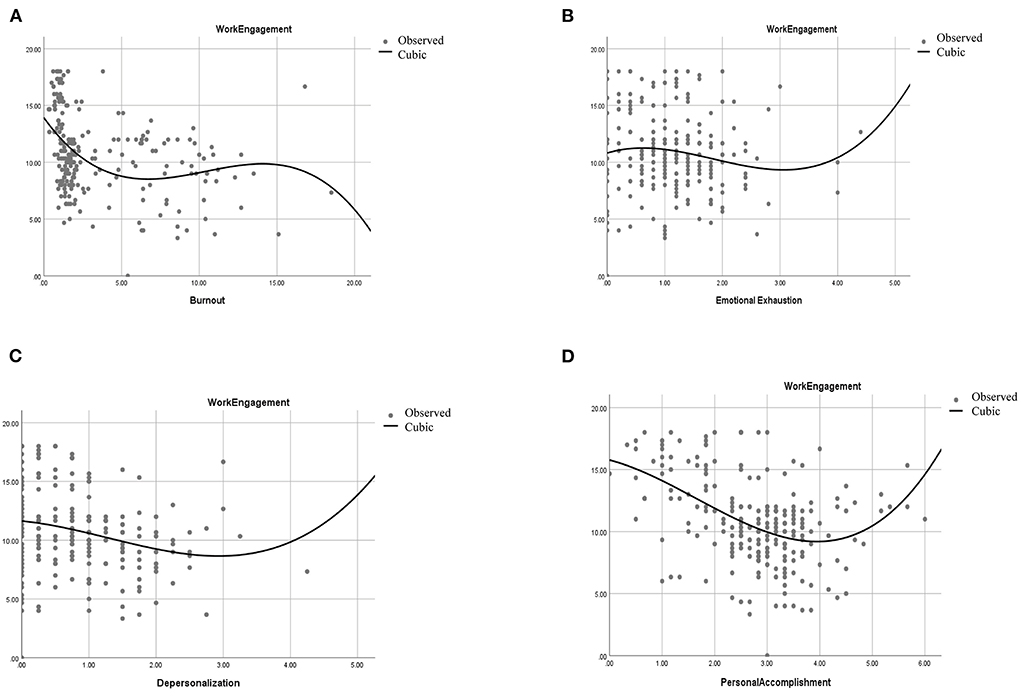
Figure 2. Curvilinear relationships. (A) Curve relationships between work engagement and burnout. (B) Curve relationship between work engagement and emotional exhaustion. (C) Curve relationship between work engagement and depersonalization. (D) Curve relationship between work engagement and personal accomplishment.
The curve estimation results showed that the fitted model constructed with work engagement as the dependent variable and “emotional exhaustion” as the independent variable was not statistically significant (P > 0.05), as shown in Model formula 2, See Table 3. The curve function model is shown in Figure 2 (Based on the all data, Figure 2B).
The best-fit model was constructed as a cubic function model with work input as the dependent variable and “depersonalization” as the independent variable (R2 = 0.061, P < 0.05), as shown in Model formula 3, See Table 3. The curvilinear function model is shown in Figure 2 (Based on the all data, Figure 2C).
Finally, with work engagement as the dependent variable and “personal accomplishment” as the independent variable, the best-fit model was constructed as a cubic function model (R2 = 0.230, P < 0.05), as shown in Model formula 4, See Table 3. The highest R2 (0.287) was found in Suzhou, and the graph of the curve function is shown in Figure 2 (Based on the all data, Figure 2D).
Discussion
Burnout is a kind of negativity that occurs among the staff in the community who serve the elderly. Work engagement determines the degree of attention to the elderly in their work and the satisfaction of the elderly in receiving services. Unlike previous studies, this study explored the relationship between burnout and the curve of work engagement for the first time. A stratified whole-group random sample was used to sample staff from institutions in different economic regions, increasing the diversity and representativeness of the model.
The results of the correlation analysis study in this study showed that there was a significant negative correlation between burnout and work engagement. The results of the simultaneous curve estimation show that the mathematical model of the cubic function between these two variables fits best. As found in Figure 2A, within the range values of burnout, the value of about 5 and about 15 points of burnout divided the curve into three segments. Work engagement increased with burnout in both intervals between 0 and 5 and after 15 points, similar to the usual findings (41–43). On a scale between 5 and 15, work engagement increases with burnout, which means that an increase in burnout instead increases work engagement. This may be because burnout reaches a certain point where it attracts the attention of other relevant leaders, who use external monitoring to push staff to take their work seriously. However, it is assumed that staff will grow weary of this supervision, and their commitment to their work will again diminish. Such supervisory hygiene factors do not guarantee staff commitment in the long term, and motivational factors are needed to motivate staff intrinsically.
The curve between work engagement and “depersonalization” and “personal accomplishment” has a U-shaped relationship. The study results found that depersonalization scores around three were negatively correlated with work engagement, and after three were positively correlated with work engagement. However, the sample size is smaller after three points. A small number of incidental responses may significantly alter the shape of the curve in the high-scoring area. Therefore, the curve between work engagement and “depersonalization” is not very strong, but a linear correlation can be established. This is consistent with the findings of Taycan et al. (44) that “depersonalization” affects work engagement. After a score of 4 for personal accomplishment, work engagement increases as the score for personal accomplishment increases. This indicates that a certain degree of “personal accomplishment” also motivates staff to work engagement. In their studies, Wu et al. (45) showed that low achievement affects work demands. Van den Berg JW (46) et al. showed that happiness affects work engagement. Van den Berg JW et al. studied happiness as similar to emotional changes. Emotions are defined as relatively cognitive sensory induced emotions (47). Individuals' emotions are influenced by various internal and external environmental factors, and this shift can be forward and backward and will be completed over time (48). Pishghadam et al. (33, 34, 49) argue that individuals can be involved (hearing and seeing something) and involved (direct experience of something) according to emotion and that the level of emotion seems to affect motivation. All of these studies may suggest that emotions affect work engagement, and this could equally be argued for a sense of accomplishment to affect work engagement. Still, there is no relevant research that indicates that reduced achievement has some positive effect on work engagement, and more research is needed to verify this.
In addition to focusing on staff emotions to increase motivation, this can also be achieved by meeting their own needs. Stroke means paying attention to your needs, strokes can be positive/negative, verbal/non-verbal, and conditional/unconditional (50). Some studies have shown that stroke promotes good student performance (51) and that there is a significant positive correlation between stroke and achieving success (8, 50, 52). The individual's psychological need for stroke is a consequence of what they have done, not an unconditional acceptance of it (32, 50, 52). Thus, acceptance of stroke potentially increases positive motivation and ultimately increases the perception of staff success, which in turn increases staff motivation and to some extent also alleviates burnout.
This study was conducted on community staff in two regions with significant economic differences, and the findings are somewhat generalizable. Secondly, this study is innovative in that it is a survey of the community staff, for which there have been fewer studies in previous research. However, this survey is a questionnaire filled out by the staff according to their situation, easily influenced by personal subjectivity. In addition, the curvilinear relationship between job burnout and work engagement has not been explored in other relevant literature, and the reader is unable to analyze the findings with other relevant literature critically, and more research is still needed to follow to verify the accuracy of this paper.
Conclusions
The curvilinear relationship between burnout and work engagement found in this study suggests that the government and related service organizations need to use a variety of approaches to help staff alleviate burnout and increase their work engagement. The study results show a cubic function between burnout and work engagement and that “personal accomplishment” is related to work engagement in a U-shaped curve. Therefore, the government and related service organizations should understand the impact of different levels of burnout on work engagement and take targeted measures to alleviate burnout and improve work engagement by targeting emotions and stroke.
Data availability statement
The original contributions presented in the study are included in the article/supplementary materials, further inquiries can be directed to the corresponding author.
Ethics statement
The studies involving human participants were reviewed and approved by Ethics Committee of Zhengzhou University (Approval No. ZZUIRB2022-07). The patients/participants provided their written informed consent to participate in this study.
Author contributions
YH received the grant, participated in the interpretation of the results and critical revision of important intellectual content of the manuscript, and approved the final version of the manuscript. GY and YH designed the study. GY wrote the main manuscript text. LW, HD, and XL collected the data. GY and HW analyzed the data. All authors reviewed the manuscript.
Funding
This study was supported by National Key Research and Development Program Projects of China (2020YFC2006100) and 2021 Henan Province Science and Technology Research Project (212102310814).
Acknowledgments
Thank to all the researchers who participated in the survey.
Conflict of interest
The authors declare that the research was conducted in the absence of any commercial or financial relationships that could be construed as a potential conflict of interest.
Publisher's note
All claims expressed in this article are solely those of the authors and do not necessarily represent those of their affiliated organizations, or those of the publisher, the editors and the reviewers. Any product that may be evaluated in this article, or claim that may be made by its manufacturer, is not guaranteed or endorsed by the publisher.
References
1. Kansoun Z, Boyer L, Hodgkinson M, Villes V, Lancon C, Fond G, et al. Burnout in French physicians: a systematic review and meta-analysis. J Affect Disord. (2018) 246:132–47. doi: 10.1016/j.jad.12056
3. Freudenberger HJ. The issues of staff burnout in therapeutic communities. J Psychoactive Drugs. (1986) 18:247–51. doi: 10.1080/0279198610472354
4. Rothenberger DA. Physician burnout and well-being: a systematic review and framework for action. Dis Colon Rectum. (2017) 60:567–76. doi: 10.1097/Dcr.0000000000000844
5. Maslach C, Schaufeli WB, Leiter MP. Job burnout. Annu Rev Psychol. (2001) 52:397–422. doi: 10.1146/annurev.psych.52.1.397
6. Wang HP, Jin YZ, Wang D, Zhao SC, Sang XG, et al. Job satisfaction, burnout, and turnover intention among primary care providers in rural China: results from structural equation modeling. BMC Family Pract. (2020) 21:8. doi: 10.1186./s12875-020-1083-8
7. Zhou XY, Pu JC, Zhong XN, Zhu D, Yin DH, Yang LN, et al. Burnout, psychological morbidity, job stress, and job satisfaction in Chinese neurologists. Neurology. (2017) 88:1727–35. doi: 10.1212/Wnl.0000000000003883
8. Noorbakhsh Z, Pishghadam R, Saboori F. Stroke and gender identity in teacher success: from learners' viewpoints. Sri Lanka J Soc Sci. (2018) 41:39–48. doi: 10.4038/sljss.v41i1.7591
9. Pishghadam R, Sahebjam S. Personality and emotional intelligence in teacher burnout. Sp J Psychol. (2012) 15:227–36. doi: 10.5209/rev_SJOP.2012.v15.n1.37314
10. Shen G. Anxiety, boredom, and burnout among efl teachers: the mediating role of emotion regulation. Front Psychol. (2022) 13:842920. doi: 10.3389/fpsyg.2022.842920
11. Madigan DJ, Kim LE. Towards an understanding of teacher attrition: a meta-analysis of burnout, job satisfaction, and teachers' intentions to quit. Teach Teach Educ. (2021) 105:103425. doi: 10.1016/j.tate.2021.103425
12. Dimou FM, Eckelbarger D, Riall TS. Surgeon burnout: a systematic review. J Am Coll Surg. (2016) 222:1230–9. doi: 10.1016/j.jamcollsurg.03022
13. Puffer JC, Knight HC, O'Neill TR, Rassolian M, Bazemore AW, Peterson LE, et al. Prevalence of burnout in board certified family physicians. J Am Board Fam Med. (2017) 30:125–6. doi: 10.3122/jabfm.02160295
14. Grassi L, Magnani K. Psychiatric morbidity and burnout in the medical profession: an Italian study of general practitioners and hospital physicians. Psychother Psychosom. (2000) 69:329–34. doi: 10.1159/000012416
15. Gomez-Polo C, Martin Casado AM, Castano A, Montero J. Epidemiological study on burnout in Spanish dentists: underlying psychological factors. Int J Environ Res Public Health. (2021) 18:3418. doi: 10.3390./ijerph182413418
16. West CP, Tan AD, Shanafelt TD. Association of resident fatigue and distress with occupational blood and body fluid exposures and motor vehicle incidents. Mayo Clinic Proceedings. (2012) 87:1138–44. doi: 10.1016/j.mayocp.07021
17. Foa C, Guarnieri MC, Bastoni G, Benini B, Giunti OM, Mazzotti M, et al. Job satisfaction, work engagement, and stress/burnout of elderly care staff: a qualitative research. Acta Biomed. (2020) 91:e2020014. doi: 10.23750./abm.v91i12-S.10918
18. Harrad R, Sulla F. Factors associated with and impact of burnout in nursing and residential home care workers for the elderly. Acta Biomed. (2018) 89:60–9. doi: 10.23750./abm.v89i7-S.7830
19. West CP, Dyrbye LN, Shanafelt TD. Physician burnout: contributors, consequences and solutions. J Intern Med. (2018) 283:516–29. doi: 10.1111/joim.12752
20. Schaufeli WB, Salanova M. Efficacy or inefficacy, that's the question: burnout and work engagement, and their relationships with efficacy beliefs. Anxiety Stress Coping. (2007) 20:177–96. doi: 10.1080/10615800701217878
21. Mitonga-Monga J, Mayer CH. Sense of coherence, burnout, and work engagement: the moderating effect of coping in the democratic Republic of Congo. Int J Environ Res Public Health. (2020) 17:4127. doi: 10.3390./ijerph17114127
22. Wake M, Green W. Relationship between employee engagement scores and service quality ratings: analysis of the national health service staff survey across 97 acute NHS trusts in England and concurrent care quality commission outcomes (2012–2016). BMJ Open. (2019) 9:26472. doi: 10.1136./bmjopen-2018-026472
23. Kawamura S, Morioka I. The effects of writing and reading aloud the positive events that take place in the workplace on work engagement and the occupational stress of care workers in welfare facilities for long-term elderly care: a crossover trial. Sangyo Eiseigaku Zasshi. (2021) 35:28 doi: 10.1539./sangyoeisei.2020-028-B
24. Mauno S, Ruokolainen M, Kinnunen U, Bloom De J. Emotional labour and work engagement among nurses: examining perceived compassion, leadership, and work ethic as stress buffers. J Adv Nurs. (2016) 72:1169–81. doi: 10.1111/jan.12906
25. Andela M, Truchot D, Huguenotte V. Work environment and elderly abuse in nursing homes: the mediating role of burnout. J Interpers Violence. (2021) 36:5709–29. doi: 10.1177/0886260518803606
26. Baghdadi NA, Farghaly Abd-El Aliem SM, Alsayed SK. The relationship between nurses' job crafting behaviours and their work engagement. J Nurs Manag. (2021) 29:214–19. doi: 10.1111/jonm.13141
27. Mohamed SA, Hendy A, Ezzat Mahmoud O, Mohamed Mohamed S. Mattering perception, work engagement and its relation to burnout amongst nurses during coronavirus outbreak. Nursing Open. (2022) 9:377–84. doi: 10.1002/nop2.1075
28. Gomez-Salgado J, Dominguez-Salas S, Romero-Martin M, Romero A, Coronado-Vazquez V, Ruiz-Frutos C, et al. Work engagement and psychological distress of health professionals during the COVID-19 pandemic. J Nurs Manag. (2021) 29:1016–25. doi: 10.1111/jonm.13239
29. Goodboy AK, Martin MM, Bolkan S. Workplace bullying and work engagement: a self-determination model. J Interpers Violence. (2020) 35:4686–708. doi: 10.1177/0886260517717492
30. Saito Y, Igarashi A, Noguchi-Watanabe M, Takai Y, Yamamoto-Mitani N. Work values and their association with burnout/work engagement among nurses in long-term care hospitals. J Nurs Manag. (2018) 26:393–402. doi: 10.1111/jonm.12550
31. Znidarsic J, Bernik M. Impact of work-family balance results on employee work engagement within the organization: the case of Slovenia. PLoS ONE. (2021) 16:e0245078. doi: 10.1371/journal.pone.0245078
32. Pishghadam R, Derakhshan A, Jajarmi H, Farani ST, Shayesteh S. Examining the role of teachers' stroking behaviors in EFL learners' active/passive motivation and teacher success. Front Psychol. (2021) 12:7314. doi: 10.3389./fpsyg.2021.707314
33. Pishghadam R, Makiahadi H, Shayesteh S, Zeynali S. Unveiling the passive aspect of motivation: insights from English language teachers' habitus. Int. J. Soc. Culture Lang. (2019) 7:15–26.
34. Pishghadam R, Shakeebaee G, Rahmani S. Sensory capital in education: the missing piece? Italian J Sociol Edu. (2019) 11:589. doi: 10.14658/pupj-ijse-2019-3-15
35. Li D, Ouyang WN. Second language learning motivation in a european context: the case of Hungary. Front Psychol. (2021) 12:4500. doi: 10.3389./fpsyg.2021.704500
36. Shimazu A, Schaufeli WB, Kubota K, Watanabe K, Kawakami N. Is too much work engagement detrimental? Linear or curvilinear effects on mental health and job performance. PLoS ONE. (2018) 13:e0208684. doi: 10.1371/journal.pone.0208684
37. Sato M, Fernandez Castillo F, Oyanedel JC. Teacher motivation and burnout of english-as-a-foreign-language teachers: do demotivators really demotivate them? Front Psychol. (2022) 13:891452. doi: 10.3389/fpsyg.2022.891452
38. Kumazawa M. Gaps too large: Four novice EFL teachers' self-concept and motivation. Teach Teach Edu. (2013) 33:45–55. doi: 10.1016/j.tate.02005
39. Yuan R, Zhang LJ. Exploring student teachers' motivation change in initial teacher education. Chin Persp Teach Teach Edu. (2016) 61:142–52. doi: 10.1016/j.tate.10010
40. Song B, Kim TY. Teacher (de)motivation from an activity theory perspective. Cases Two Exp EFL Teach South Korea Sys. (2016) 57:134–45. doi: 10.1016/j.system.02006
41. Basinska BA, Daderman AM. Work values of police officers and their relationship with job burnout and work engagement. Front Psychol. (2019) 10:442. doi: 10.3389/fpsyg.2019.00442
42. Sun B, Fu L, Yan C, Wang Y, Fan L. Quality of work life and work engagement among nurses with standardised training: The mediating role of burnout and career identity. Nurse Educ Pract. (2021) 58:103276. doi: 10.1016/j.nepr.2021.103276
43. Zhang X, Bai X, Bian L, Wang M. The influence of personality, alexithymia and work engagement on burnout among village doctors in China: a cross-sectional study. BMC Public Health. (2021) 21:1507. doi: 10.1186/s12889-021-11544-8
44. Taycan O, Taycan SE, Celik C. Relationship of burnout with personality, alexithymia, and coping behaviors among physicians in a semiurban and rural area in Turkey. Arch Environ Occup Health. (2014) 69:159–66. doi: 10.1080/19338244.2013.763758
45. Wu H, Liu L, Sun W, Zhao X, Wang JN, Wang L, et al. Factors related to burnout among Chinese female hospital nurses: cross-sectional survey in Liaoning Province of China. J Nurs Manag. (2014) 22:621–9. doi: 10.1111/jonm.12015
46. van den Berg JW, Mastenbroek NJJM, Scheepers RA, Jaarsma ADC. Work engagement in health professions education. Med Teach. (2017) 39:1110–8. doi: 10.1080/01420171359522
47. Pishghadam R, Adamson B, Shayesteh S. Emotion-based language instruction (EBLI) as a new perspective in bilingual education. Multi Edu. (2013) 3:9. doi: 10.1186/2191-5059-3-9
48. Miri MA, Pishghadam R. Toward an emotioncy based education: a systematic review of the literature. Front Psychol. (2021) 12:727186. doi: 10.3389/fpsyg.2021.727186
49. Pishghadam R., Jajarmi H., Shayesteh S. Conceptualizing sensory relativism in light of emotioncy: a movement beyond linguistic relativism. Int. J. Soc. Culture Lang. (2015) 4:11–21.
50. Pishghadam R, Derakhshan A, Zhaleh K. The interplay of teacher success, credibility, and stroke with respect to EFL students' willingness to attend classes. Pol Psychol Bullet. (2020) 50:284–92. doi: 10.24425/ppb.2019.131001
51. Stewart I, Joines V. TA Today: A New Introduction to Transactional Analysis. Oral Surgery Oral Medicine and Oral Pathology. Nottingham: Lifespace (1987).
Keywords: curvilinear relationship, burnout, work engagement, community services for the elderly, staff
Citation: Yang G, Wei H, Wan L, Dong H, Liang X and He Y (2022) Curvilinear relationship between burnout and work engagement among staff in community services for the elderly: A correlation study. Front. Public Health 10:939649. doi: 10.3389/fpubh.2022.939649
Received: 09 May 2022; Accepted: 30 June 2022;
Published: 22 July 2022.
Edited by:
Dragan Mijakoski, Institute of Occupational Health of RNM, North MacedoniaReviewed by:
Reza Pishghadam, Ferdowsi University of Mashhad, IranGuoqiang Liang, Beijing University of Technology, China
Sasho Stoleski, Saints Cyril and Methodius University of Skopje, North Macedonia
Copyright © 2022 Yang, Wei, Wan, Dong, Liang and He. This is an open-access article distributed under the terms of the Creative Commons Attribution License (CC BY). The use, distribution or reproduction in other forums is permitted, provided the original author(s) and the copyright owner(s) are credited and that the original publication in this journal is cited, in accordance with accepted academic practice. No use, distribution or reproduction is permitted which does not comply with these terms.
*Correspondence: Yan He, aDE4NjM4Nzg3Mzk3QDE2My5jb20=
 Guangmei Yang
Guangmei Yang Huiyan Wei
Huiyan Wei Leping Wan
Leping Wan Yan He
Yan He